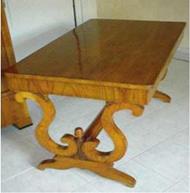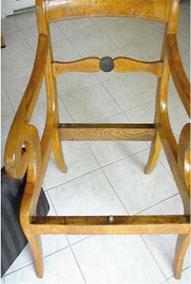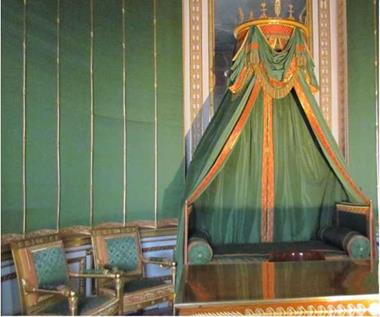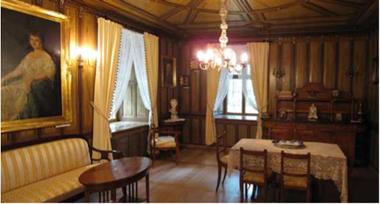Furniture from this period is characterised by a solid built, choice of appropriate raw material and a design that meets the requirements of users. For their production, the following wood was mostly used: mahogany, walnut, birch, cherry, pear, elm, poplar, ash and oak.
Biedermeier case furniture is characterised by a similar, but greatly simplified form in relation to the analogous furniture manufactured in England at the end of the eighteenth century (Fig. 1.45). Most of the panel elements of furniture were joined using an oblique dovetail joint. The bottoms of drawers were inserted in a groove, while the face was situated in one plane with the rest of the top surface of the piece of furniture. Frame panel or, less often, board back walls were joined with the body using tongue and groove joints. A popular piece of furniture among townspeople of that period was the escritoire. Its essential element was the lifting flap on hinges, behind which there were numerous drawers and compartments (Sienicki 1954).
Glass cases were also made, glazed in the front and on the sides, which served to store china, small objects, miniatures and other memorabilia. Interchangeably with glass cases, lightweight shelves or glass dressers functioned.
Tables were constructed from a round or oval board supported on a frame, which was usually a single column or legs in the shape of a lyre. In the case of the table, there were one or two drawers. Worktops were covered with a mahogany veneer inlayed with narrow highlights of light-coloured veneers (string inlay) (Fig. 1.46).
|
Fig. 1.44 Napoleon’s bedroom in Fontainebleau |
|
Fig. 1.45 Biedermeier salon inside the Loewenfeld mansion (The Irena and Mieczyslaw Mazaraki Museum, Chrzanow, Poland) |
The most significant structural changes occurred, however, in the group of skeletal furniture. Next to frame and rail systems came also rack constructions. In the case of rack construction, the side frames were strengthened by joints with a front and rear rails. To join them, usually mortise and tenon joints, double mortise
Fig. 1.46 Table structure made in Biedermeier style
 and tenon joints as well as mortise and tenon joints with offset were used. The use of double mortise and tenon joints as well as mortise and tenon joints with offset increased the usable surface of contact of the joined elements, thus the strength and rigidity of the joint. This was the next step in the development of skeletal furniture designs. Backrests and support legs were joined in a similar way. Because during this time pine wood was begun to be used, artisans started to use veneering of elements of skeletal furniture. In contrast to the hardware made in classical style, skeletal furniture is characterised by universality of use of curved supports, backrests and legs (Fig. 1.47).
and tenon joints as well as mortise and tenon joints with offset were used. The use of double mortise and tenon joints as well as mortise and tenon joints with offset increased the usable surface of contact of the joined elements, thus the strength and rigidity of the joint. This was the next step in the development of skeletal furniture designs. Backrests and support legs were joined in a similar way. Because during this time pine wood was begun to be used, artisans started to use veneering of elements of skeletal furniture. In contrast to the hardware made in classical style, skeletal furniture is characterised by universality of use of curved supports, backrests and legs (Fig. 1.47).
The seats of the chairs were usually lined with light-coloured, floral or striped cretonnes, baize fabrics, as well as silk, damask or embroidered fabrics.
 Fig. 1.47 Frame structure of a piece of furniture from the Biedermeier period
Fig. 1.47 Frame structure of a piece of furniture from the Biedermeier period
Large, wide sofas, usually in a heavy and massive form, were also commonly produced. The main decorations of wooden elements of the furniture include swans with outstretched necks, cornucopia, griffins, plant twines and similar motifs, most often gilded.
Also during this period, for the first time in the spring layer specially designed springs were used. Thanks to this, furniture was more attractive and the comfort of use improved significantly.





